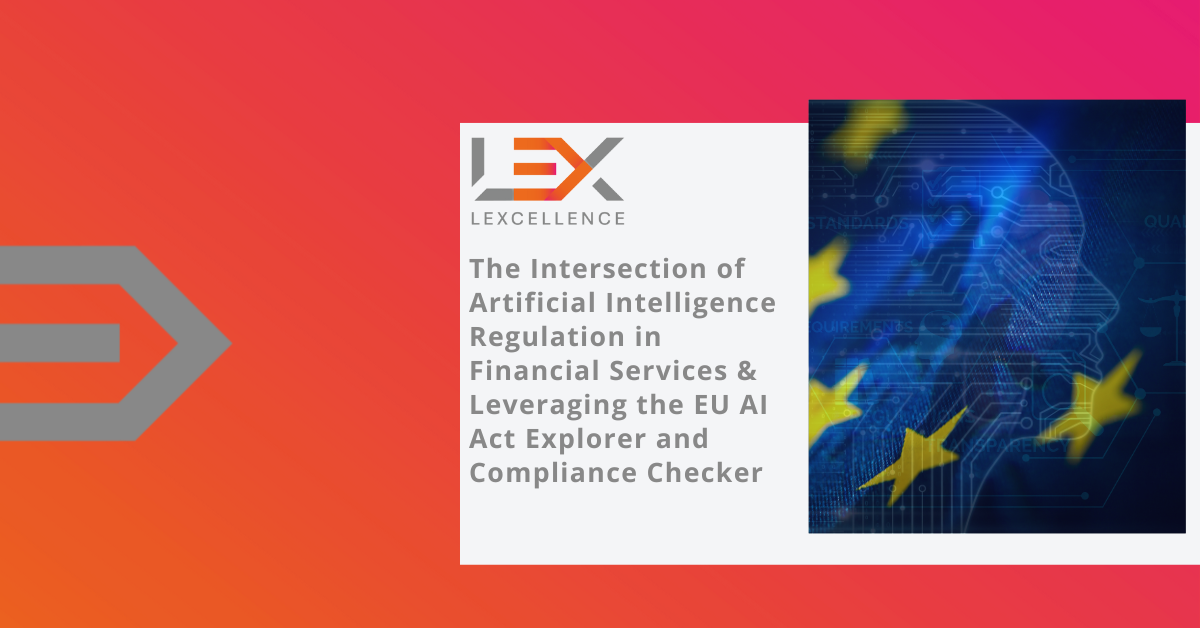The Intersection of Artificial Intelligence Regulation in Financial Services & Leveraging the EU AI Act Explorer and Compliance Checker

The financial services industry stands at the forefront of technological innovation, with artificial intelligence (AI) emerging as a transformative force. However, alongside the promises of efficiency and insight, AI adoption in finance brings forth complex regulatory challenges. As financial institutions navigate the intricate web of compliance, the introduction of the EU AI Act alongside the Digital Operational Resilience Act (DORA) marks a pivotal moment in regulatory history.
In this dynamic landscape, understanding the regulatory landscape becomes paramount for financial institutions integrating AI systems. The EU AI Act, a comprehensive framework for AI regulation, sets harmonized rules for the use of AI systems within the Union. It aims to ensure ethical AI deployment while mitigating potential risks associated with its use. Concurrently, DORA mandates digital operational resilience, underscoring the importance of robust infrastructure in the face of technological disruptions.
The intersection of the EU AI Act and DORA presents a dual challenge for financial institutions. They must not only adhere to the ethical provisions of the AI Act but also ensure digital operational resilience as mandated by DORA. This necessitates a nuanced understanding of regulatory frameworks and their implications on AI deployment strategies.
The EU Council's recent unanimous approval of the AI Act marks a significant milestone in global AI regulation. Originally proposed in April 2021, the Act addresses challenges posed by rapid technological advancements. Despite disruptions, including considerations on generative AI, the Act establishes harmonized rules for AI systems' placement and use in the Union. Notably, it is set for a plenary vote provisionally scheduled for 10-11 April 2024.
Understanding the Regulatory Landscape
Financial institutions integrating AI systems face the dual challenge of adhering to the EU AI Act’s provisions on ethical AI use and managing digital operational resilience as mandated by DORA. Understanding the crossover between these regulatory frameworks becomes paramount.
Exploring Regulatory Insights with the EU AI Act Explorer
The EU AI Act Explorer (https://artificialintelligenceact.eu/ai-act-explorer/) and Compliance Checker (https://artificialintelligenceact.eu/assessment/eu-ai-act-compliance-checker/) emerge as indispensable tools for financial institutions seeking clarity amid regulatory complexities. The EU AI Act Explorer offers detailed insights into the nuances of the AI Act, allowing institutions to explore its provisions comprehensively. The Compliance Checker tool aids financial institutions in honing their use cases to align with relevant sections of the AI Act. By providing targeted guidance, it facilitates adherence to regulatory requirements and fosters ethical AI deployment practices.
EU Artificial Intelligence Act
The EU Artificial Intelligence Act, unanimously approved by the Council of the EU, sets harmonized rules for the use of AI systems within the Union. The Act introduces stringent regulations to ensure the ethical deployment of AI while mitigating potential risks associated with its use.
Key Takeaways from the EU Artificial Intelligence Act:
- Defining AI Systems: The AI Act defines AI systems broadly, emphasizing autonomy and adaptiveness.
- Prohibited AI Practices: The Act outlines a closed list of prohibited AI practices, including real-time remote biometric identification for law enforcement.
- Classification of High-Risk AI Systems: High-risk AI systems are subjected to extensive regulation and obligations, ensuring transparency, accountability, and cybersecurity.
- Important Exception to High-Risk AI Qualification: An exception is provided for AI systems with minimal risk to health, safety, or fundamental rights.
- Obligations for High-Risk AI Systems: Providers must meet strict requirements to ensure trustworthiness, transparency, and accountability.
- Obligations Across the Value Chain: Importers, distributors, and deployers of high-risk AI systems face compliance obligations.
- Obligations for Deployers: Deployers must adhere to usage instructions, ensure human oversight, and maintain operational logs.
- Fundamental Rights Impact Assessment: Public sector bodies and private entities must conduct a fundamental rights impact assessment for high-risk AI systems.
- Shifting Responsibilities Along the Value Chain: Importers, distributors, or deployers may be considered providers under certain conditions.
- Right to an Explanation: Individuals have the right to meaningful explanations for decisions made by high-risk AI systems.
- Broad Right to Complain: Individuals and entities have the right to lodge complaints with market surveillance authorities.
- General Purpose AI Models: GPAI models are regulated separately, with additional obligations for models with systemic risks.
- Transparency Obligations for AI Systems and GPAI Models: Specific transparency obligations apply to certain AI systems and GPAI models.
- Complex Compliance and Enforcement Structure: The AI Act establishes a complex governance structure involving multiple entities for compliance and enforcement.
- Enforcement and Next Steps: Market surveillance authorities have the power to enforce rules and impose penalties for non-compliance.
- Looking Beyond the AI Act: The AI Act is one component of a broader legal landscape governing AI, including intellectual property, data protection, contracts, liability, and cybersecurity laws.
Embracing Responsible AI Deployment
In conclusion, the EU AI Act Explorer and Compliance Checker serve as indispensable resources for financial institutions navigating the complexities of AI regulation. By embracing ethical AI deployment practices and robust compliance strategies, institutions can confidently navigate the regulatory landscape and drive responsible innovation in the financial services sector. As AI continues to reshape the financial landscape, proactive engagement with regulatory frameworks will be key to fostering trust and sustainability in the digital era.





